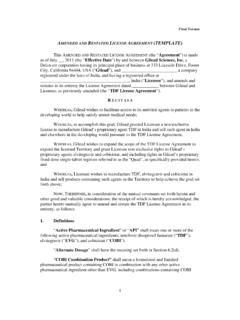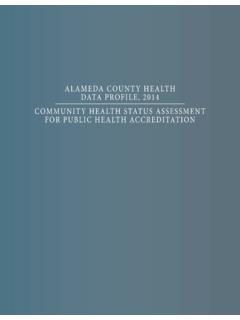Transcription of AmBisome (amphotericin B) liposome for injection
1 1 AmBisome (amphotericin B) liposome for injection Revised: March 2012 DESCRIPTION AmBisome for injection is a sterile, non-pyrogenic lyophilized product for intravenous infusion. Each vial contains 50 mg of amphotericin B, USP, intercalated into a liposomal membrane consisting of approximately 213 mg hydrogenated soy phosphatidylcholine; 52 mg cholesterol, NF; 84 mg distearoylphosphatidylglycerol; mg alpha tocopherol, USP; together with 900 mg sucrose, NF; and 27 mg disodium succinate hexahydrate as buffer. Following reconstitution with Sterile Water for injection , USP, the resulting pH of the suspension is between 5-6.
2 AmBisome is a true single bilayer liposomal drug delivery system. Liposomes are closed, spherical vesicles created by mixing specific proportions of amphophilic substances such as phospholipids and cholesterol so that they arrange themselves into multiple concentric bilayer membranes when hydrated in aqueous solutions. Single bilayer liposomes are then formed by microemulsification of multilamellar vesicles using a homogenizer. AmBisome consists of these unilamellar bilayer liposomes with amphotericin B intercalated within the membrane. Due to the nature and quantity of amphophilic substances used, and the lipophilic moiety in the amphotericin B molecule, the drug is an integral part of the overall structure of the AmBisome liposomes.
3 AmBisome contains true liposomes that are less than 100 nm in diameter. A schematic depiction of the liposome is presented below. 2 Note: Liposomal encapsulation or incorporation into a lipid complex can substantially affect a drug s functional properties relative to those of the unencapsulated drug or non-lipid associated drug. In addition, different liposomal or lipid-complex products with a common active ingredient may vary from one another in the chemical composition and physical form of the lipid component. Such differences may affect the functional properties of these drug products.
4 Amphotericin B is a macrocyclic, polyene, antifungal antibiotic produced from a strain of Streptomyces nodosus. Amphotericin B is designated chemically as: [1R-(1R*,3S*,5R*,6R*,9R*,11R*,15S*,16R*, 17R*,18S*, 19E,21E,23E,25E,27E,29E,31E,33R*,35S*,36 R*,37S*)]-33-[(3-Amino-3,6-dideoxy- -D-mannopyranosyl)oxy]-1,3,5,6,9,11,17,3 7-octahydroxy-15,16,18-trimethyl-13-oxo- 14,39-dioxabicyclo[ ]nonatriaconta-19,21,23,25,27,29,31-hept aene-36-carboxylic acid (CAS ). Amphotericin B has a molecular formula of C47H73NO17 and a molecular weight of The structure of amphotericin B is shown below: MICROBIOLOGY Mechanism of Action Amphotericin B, the active ingredient of AmBisome , acts by binding to the sterol component, ergosterol, of the cell membrane of susceptible fungi.
5 It forms transmembrane channels leading to alterations in cell permeability through which monovalent ions (NA+, K+, H+, and Cl-) leak out of the cell resulting in cell death. While amphotericin B has a higher affinity for the ergosterol component of the fungal cell membrane, it can also bind to the cholesterol component of the mammalian cell leading to cytotoxicity. AmBisome , the liposomal preparation of amphotericin B, has been shown to penetrate the cell wall of both extracellular and intracellular forms of susceptible fungi. 3 Activity In Vitro and In Vivo AmBisome has shown in vitro activity comparable to amphotericin B against the following organisms: Aspergillus fumigatus, Aspergillus flavus, Candida albicans, Candida krusei, Candida lusitaniae, Candida parapsilosis, Candida tropicalis, Cryptococcus neoformans, and Blastomyces dermatitidis.
6 Drug Resistance Mutants with decreased susceptibility to amphotericin B have been isolated from several fungal species after serial passage in culture media containing the drug, and from some patients receiving prolonged therapy. Drug combination studies in vitro and in vivo suggest that imidazoles may induce resistance to amphotericin B. However, the clinical relevance of drug resistance has not been established. Susceptibility Testing Standardized methods of in vitro antifungal susceptibility testing have been developed for testing yeasts (1,2,3) and filamentous fungi (4,5).
7 The clinical relevance of the test results is not always clear. CLINICAL PHARMACOLOGY Pharmacokinetics The assay used to measure amphotericin B in the serum after administration of AmBisome does not distinguish amphotericin B that is complexed with the phospholipids of AmBisome from amphotericin B that is uncomplexed. The pharmacokinetic profile of amphotericin B after administration of AmBisome is based upon total serum concentrations of amphotericin B. The pharmacokinetic profile of amphotericin B was determined in febrile neutropenic cancer and bone marrow transplant patients who received 1-2 hour infusions of 1 to 5 mg/kg/day AmBisome for 3 to 20 days.
8 The pharmacokinetics of amphotericin B after administration of AmBisome is nonlinear such that there is a greater than proportional increase in serum concentrations with an increase in dose from 1 to 5 mg/kg/day. The pharmacokinetic parameters of total amphotericin B (mean SD) after the first dose and at steady state are shown in the table below. 4 Pharmacokinetic Parameters of AmBisome Dose (mg/kg/day): 1 5 Day 1 n 8 Last n 7 1 n 7 Last n 7 1 n 12 Last n 9 Parameters Cmax (mcg/mL) 21 83 AUC0-24 (mcg hr/mL) 27 14 60 20 65 33 197 183 269 96 555 311 t (hr) 7 2 Vss(L/kg) Cl (mL/hr/kg)
9 39 22 17 6 51 44 22 15 21 14 11 6 Distribution Based on total amphotericin B concentrations measured within a dosing interval (24 hours) after administration of AmBisome , the mean half-life was 7-10 hours. However, based on total amphotericin B concentration measured up to 49 days after dosing of AmBisome , the mean half-life was 100-153 hours. The long terminal elimination half-life is probably a slow redistribution from tissues. Steady state concentrations were generally achieved within 4 days of dosing. Although variable, mean trough concentrations of amphotericin B remained relatively constant with repeated administration of the same dose over the range of 1 to 5 mg/kg/day, indicating no significant drug accumulation in the serum.
10 Metabolism The metabolic pathways of amphotericin B after administration of AmBisome are not known. Excretion The mean clearance at steady state was independent of dose. The excretion of amphotericin B after administration of AmBisome has not been studied. Pharmacokinetics in Special Populations Renal Impairment The effect of renal impairment on the disposition of amphotericin B after administration of AmBisome has not been studied. However, AmBisome has been successfully administered to patients with pre-existing renal impairment (see DESCRIPTION OF CLINICAL STUDIES).














